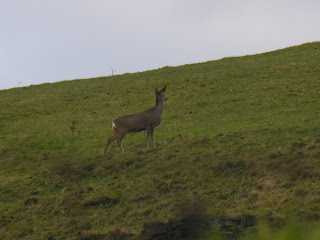
 These roe deer (4 does and a buck) were grazing near a busy road at 3pm! Some naturalists are dubious about them being around. The only problems I can forsee are damage to gardens/allotments, encouraging hunting with dogs/snares and traffic accidents. Otherwise I would say they are a definite plus. What does anybody else think?
These roe deer (4 does and a buck) were grazing near a busy road at 3pm! Some naturalists are dubious about them being around. The only problems I can forsee are damage to gardens/allotments, encouraging hunting with dogs/snares and traffic accidents. Otherwise I would say they are a definite plus. What does anybody else think?

Most definitely an asset, as any beautiful wild creature is. What would life be like if we didn't have these surprise highlights to our day. They could come to my allotment any day (if I had one)! I'm sure someone will shoot me down with that statement!!
ReplyDeleteLinda I agree they are a pleasure to see. They are in the fields at the back of our house, early morning sights only. I had a female red a while back at around 10am, now that was special!
ReplyDeleteWhether they are an asset depends on your perspective. They are certainly beautiful to see and are much more common locally than people realise. Until about 12 years ago, roe deer had never been seen in the upper valley, probably for a few hundred years. Then they suddenly arrived and ate all the tops off rosebay willowherb and made themselves at home.
ReplyDeleteRoe deer are mainly browers. For anyone who likes to see naturally regenerating woodlands, the presence of roe deer can stop this natural process. Depending on the numbers of deer, most understorey, including brambles will be much reduced or disappear entirely.
There are reputedly more numbers of roe deer throughout England than at any time since the Norman Conquest.
They are a native mammal and, in small numbers in large wooded areas, they will keep open clearings. They have no natural predators. If we could regain the wolf and bear, then maybe deer fences would not be necessary.
In the middle ages, deer were not tolerated because of all the damage done to coppice stools and crops.
With the interest now in planting trees and managing woodlands, I am afraid the deer could not have arrived at a worse time.
But, mine is just one perspective. I am sure there are plenty of others.
Good point Philip, young woodland is seemingly at risk but open areas are to be encouraged. Fencing new growth would be costly.
ReplyDeletePerhaps selective culling may be needed to keep numbers down, but that would raise other eyebrows. Deer stalking seems pretty common in England but I personally don't like the idea. I do not think we have a problem yet.
The reintroduction of wolves and bears would be an interesting alternative though.
We don't have a problem yet, not because there aren't enough deer numbers, but because there are very few local woodlands that are managed by thinning or coppicing. Most of our woods are devoid of understorey or regrowth because of the shade.
ReplyDeleteOpen a wood up by felling and the deer will be in quicksticks to eat all seedlings and re-growth. Once a good area for feeding has been found, they are very determined creatures. Open glades are good but if coppice is required; fence the deer out if you don't want to waste your time.
I'm fairly sure coppice was carefully fenced and probably the deer hunted as well in the days when coppicing was an important part of the economy.
ReplyDeleteDeer have been implicated in reducing available nightingale cover in the south east, but the wood behind my house used to have grasses and a few ferns as the herb layer 15 years ago. Now it has impenetrable bramble over much of it. I had a wood warbler nesting there once, but the habitat's not right now.